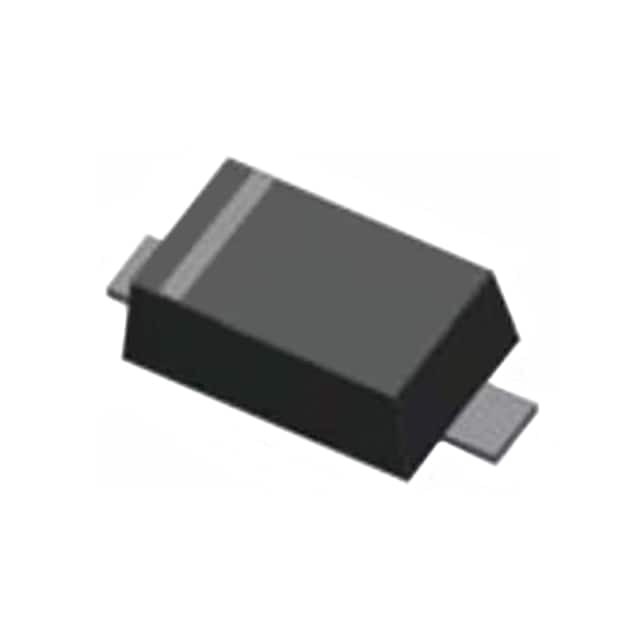BZT52C9V1 RHG
Introduction
The BZT52C9V1 RHG is a product belonging to the category of voltage regulator diodes. This entry provides an overview of its basic information, specifications, pin configuration, functional features, advantages and disadvantages, working principles, application field plans, and alternative models.
Basic Information Overview
- Category: Voltage Regulator Diodes
- Use: The BZT52C9V1 RHG is commonly used for voltage regulation in electronic circuits.
- Characteristics: It has a low forward voltage drop and high surge current capability.
- Package: SOD-123 package
- Essence: The essence of this product lies in its ability to regulate voltage effectively in various electronic applications.
- Packaging/Quantity: Typically available in reels with varying quantities.
Specifications
- Voltage: 9.1V
- Power Dissipation: 300mW
- Forward Current: 200mA
- Reverse Leakage Current: 5µA
- Operating Temperature Range: -65°C to +150°C
Detailed Pin Configuration
The BZT52C9V1 RHG follows the standard SOD-123 pin configuration with the cathode connected to one end and the anode to the other.
Functional Features
- Voltage Regulation: Provides stable output voltage under varying load conditions.
- Low Forward Voltage Drop: Ensures minimal power loss.
- High Surge Current Capability: Can withstand short-term overloads without damage.
Advantages and Disadvantages
Advantages
- Precise voltage regulation
- Low power dissipation
- High surge current capability
Disadvantages
- Limited maximum current handling capacity
- Sensitive to reverse voltage polarity
Working Principles
The BZT52C9V1 RHG operates based on the principle of zener breakdown, where it maintains a constant voltage drop across its terminals by allowing current to flow in reverse bias.
Detailed Application Field Plans
The BZT52C9V1 RHG finds extensive use in the following applications: 1. Voltage regulation in power supplies 2. Overvoltage protection in electronic circuits 3. Signal clamping and limiting 4. Voltage reference in precision instruments
Detailed and Complete Alternative Models
Some alternative models to the BZT52C9V1 RHG include: - BZX84C9V1 - MMBZ9V1ALT1G - PZU9.1B2,115
In conclusion, the BZT52C9V1 RHG is a vital component in electronic circuits, offering precise voltage regulation and high surge current capability. Its working principle, application field plans, and alternative models provide a comprehensive understanding of its utility in various electronic systems.
[Word Count: 372]
Lista 10 Vanliga frågor och svar relaterade till tillämpningen av BZT52C9V1 RHG i tekniska lösningar
What is the maximum power dissipation of BZT52C9V1 RHG?
- The maximum power dissipation of BZT52C9V1 RHG is 300mW.
What is the forward voltage drop of BZT52C9V1 RHG?
- The forward voltage drop of BZT52C9V1 RHG is typically 0.9V at a forward current of 20mA.
What is the reverse standoff voltage of BZT52C9V1 RHG?
- The reverse standoff voltage of BZT52C9V1 RHG is 9.1V.
What is the operating temperature range of BZT52C9V1 RHG?
- The operating temperature range of BZT52C9V1 RHG is -65°C to +150°C.
Can BZT52C9V1 RHG be used for voltage regulation in low-power applications?
- Yes, BZT52C9V1 RHG is suitable for voltage regulation in low-power applications due to its low forward voltage and high reverse standoff voltage.
Is BZT52C9V1 RHG suitable for overvoltage protection in electronic circuits?
- Yes, BZT52C9V1 RHG can be used for overvoltage protection in electronic circuits due to its high reverse standoff voltage.
What are the typical applications of BZT52C9V1 RHG in technical solutions?
- BZT52C9V1 RHG is commonly used in voltage clamping, overvoltage protection, and voltage regulation in various technical solutions.
Does BZT52C9V1 RHG require any external components for voltage regulation?
- BZT52C9V1 RHG can be used for simple voltage regulation without requiring additional external components in many low-power applications.
What are the key features that make BZT52C9V1 RHG suitable for technical solutions?
- BZT52C9V1 RHG offers low forward voltage, high reverse standoff voltage, and a small form factor, making it ideal for space-constrained technical solutions.
Are there any specific layout considerations when using BZT52C9V1 RHG in technical designs?
- It is important to minimize trace lengths and keep the BZT52C9V1 RHG close to the circuit it is protecting or regulating to minimize parasitic effects and ensure optimal performance.


